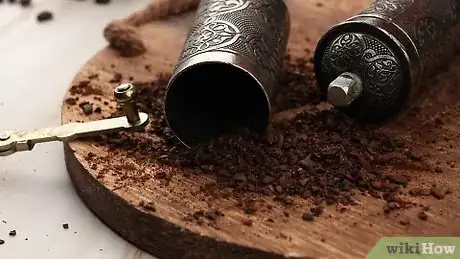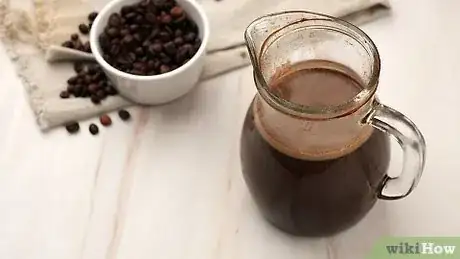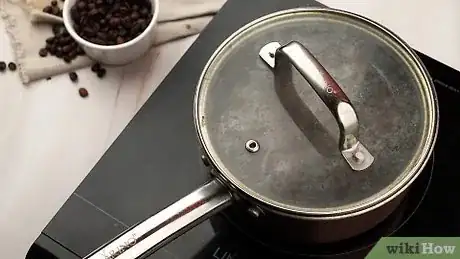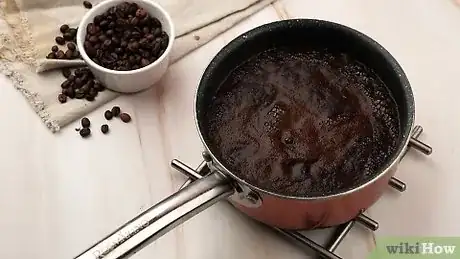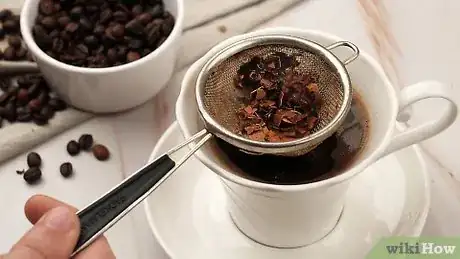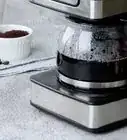This article was co-authored by Rich Lee. Rich is the Coffee & Food Program Director of Spro Coffee Lab in San Francisco, a California-based company that specializes in craft coffee, experimental mocktails, and culinary food science. Together with his team, Rich strives to bring forth a uniquely transcendent experience, free of stereotypical eats and drinks. Prior to owning his own business, Rich was a barista for big name coffee retailers such as Blue Bottle Coffee and Sightglass.
wikiHow marks an article as reader-approved once it receives enough positive feedback. This article has 13 testimonials from our readers, earning it our reader-approved status.
This article has been viewed 220,889 times.
While coffee is a favorite daily habit for many people, it has its drawbacks. Coffee can stain your teeth, make you jittery and unfocused, and coffee's high acidity can irritate sensitive stomachs. Fortunately, there are ways to prepare coffee that remove much of its acidity. You can start by choosing a type of coffee that's lower in acidity and then adjust the method you use to brew it. Cold brewing is one of the most popular ways to lower acidity in coffee, but you can also boil coffee with crushed eggshells to help remove some of the acidity. You may want to try both methods to see which one agrees most with your stomach.
Steps
Choosing the Right Coffee
-
1Select coffee that's advertised as low-acid. Some coffee beans undergo processing with steam or solvents to remove some of their acidity. Other coffee beans are naturally low in acid because of the area of the world that they grow in. Start with a coffee that's designed to be low-acid if you're concerned about acidity.
- Coffees that are processed to remove the acidity are often marketed as “mild” or “stomach-friendly.”
- Many coffees grown in Hawaii, Sumatra, Brazil, India, and the Caribbean are naturally lower in acid.
-
2Opt for a dark roast coffee. Dark roast coffees, such as Italian and French roast, are usually lower in acid than light or medium roast varieties. That's because coffee undergoes chemical changes as it roasts, so the longer that it does, the more acid that is removed. Choose a dark roast coffee and make it using any method that you prefer.
- Dark roast coffee also causes less acid to be secreted by the stomach than light or medium roasts.
- If you're not used to drinking dark roast, use a smaller amount than you would of your usual light or medium roast until you're accustomed to the taste.
Advertisement -
3Use coarsely ground coffee. If coffee beans are ground too finely, too much of the acid may be extracted during the brewing process. To reduce the acid in your coffee, opt for a coarser grind, which isn't likely to be over-extracted when you're brewing your coffee.[1]
- You may want to try a medium ground coffee to see how it affects your stomach. However, avoid fine and extra fine ground coffees.
Cold-Brewing Coffee
-
1Fill a fine mesh bag with ground coffee. Take a fine mesh food grade bag, usually used for making nut milk, and place 4 ½ ounces (128 g) of ground coffee in the bag. Cinch or fasten the bag closed so the coffee won't come out.[2]
- These types of mesh bags are reusable, so you'll be able to wash it and use it the next time that you brew coffee.
- If you don't have a mesh bag, you can mix the ground coffee directly into the water in the next step. However, you'll have to strain the coffee concentrate to remove the grounds after you've refrigerated it. Pour it through a fine mesh sieve before mixing the concentrate with water.
-
2Put the bag in a pitcher and fill it with water. When the coffee is secure in the mesh bag, place it in the bottom of a 2-quart (1.9 l) pitcher. Add enough cold water to the pitcher to fill it to the brim.[3]
- For the best tasting coffee, use filtered water.
-
3Refrigerate the pitcher overnight. Once the coffee is in the pitcher and it's filled with water, place it in the refrigerator. The coffee will need to brew for at least 12 hours, so it's a good idea to place it in the fridge the night before you plan to drink the coffee.[4]
- You may want to experiment with different brew times to see which results in the best tasting coffee. Start with 12 hours, and play around until you're happy with the flavor.
-
4Remove the bag from the pitcher. After the coffee has brewed for approximately 12 hours, take the pitcher out of the refrigerator. Pull the mesh bag with the coffee out of the water, and squeeze it over the pitcher to extract all of the coffee flavor before discarding the grounds.[5]
- Make sure to wash the mesh bag thoroughly, so it's ready for the next time you plan to brew coffee.
-
5Mix the coffee concentrate with hot water. The liquid in the pitcher will be an extremely concentrated form of coffee, so you need to dilute it with water. Mix 1 part of the coffee concentrate with 1 part of hot water for a cup of hot coffee.[6]
- Coffee that is prepared through cold brewing is 67% less acidic than coffee prepared through hot brewing.
- You can also mix the coffee concentrate with cold water and add ice if you prefer iced coffee.
-
6Keep the leftover concentrate in the refrigerator. If you don't use up all of the coffee concentrate, store it in the fridge. Unlike traditional hot brewed coffee, it won't go stale so it can keep for up to two weeks.[7]
Boiling Coffee with Eggshells
-
1Combine the coffee, water, and eggshells in a pan, and bring to a boil. Add 10 tablespoons (54 g) of medium-ground coffee, 10 cups (2.4 l) of cold water, and 5 empty egg shells that have been crushed to a large sauce pan. Turn the burner to medium-high to bring the mixture to a boil.[8]
- Make sure to use a nonreactive pan for boiling the coffee.
- The pan should be partially covered while you're waiting for it to come to a boil.
-
2Simmer the mixture for several minutes. Once the coffee mixture has come to a boil, reduce the heat to medium-low. Cover the pan completely, and allow it to simmer for 5 to 7 minutes.[9]
- If the mixture isn't simmering, you may need to raise the heat to medium.
-
3Allow the mixture to stand for a couple of minutes. When the coffee mixture has simmered for several minutes, remove the pan from the burner. Let the mixture stand until the coffee grounds settle, which should take approximately 2 minutes.[10]
-
4Strain the coffee into a pot. After the coffee grounds have settled, use a fine mesh sieve to strain the coffee ground and egg shells from the mixture. Transfer the coffee to a pot, and serve.[11]
Expert Q&A
-
QuestionDoes boiling coffee make it less acidic?
 Rich LeeRich is the Coffee & Food Program Director of Spro Coffee Lab in San Francisco, a California-based company that specializes in craft coffee, experimental mocktails, and culinary food science. Together with his team, Rich strives to bring forth a uniquely transcendent experience, free of stereotypical eats and drinks. Prior to owning his own business, Rich was a barista for big name coffee retailers such as Blue Bottle Coffee and Sightglass.
Rich LeeRich is the Coffee & Food Program Director of Spro Coffee Lab in San Francisco, a California-based company that specializes in craft coffee, experimental mocktails, and culinary food science. Together with his team, Rich strives to bring forth a uniquely transcendent experience, free of stereotypical eats and drinks. Prior to owning his own business, Rich was a barista for big name coffee retailers such as Blue Bottle Coffee and Sightglass.
Professional Barista Possibly! Brewing coffee for longer can also help balance out some of the acidity.
Possibly! Brewing coffee for longer can also help balance out some of the acidity. -
QuestionHow much is the coffee to water ratio for cold brewing?
 Community AnswerThe ratio is 4 ½ (128 g) of ground coffee to 2-quarts (1.9 l) of water.
Community AnswerThe ratio is 4 ½ (128 g) of ground coffee to 2-quarts (1.9 l) of water. -
QuestionCan I add ground eggshells to the coffee I put in the filter of a coffee-maker instead of boiling them in a pot?
 MicheleTop AnswererYou can, but it won't be as effective. Using a pot allows the eggshells time to absorb the acid.
MicheleTop AnswererYou can, but it won't be as effective. Using a pot allows the eggshells time to absorb the acid.
Warnings
- Be aware that cold brewing extracts the coffee's caffeine much more efficiently than hot brewing, with the result that coffee brewed using this method can contain nearly twice as much caffeine as your usual cup. Cutting your coffee grounds with decaf grounds can mitigate this effect.⧼thumbs_response⧽
Things You'll Need
Cold Brewing Coffee
- A fine mesh bag
- 4 ½ ounces (128 g) ground coffee
- Cold water
- Hot water, to mix with the concentrate
Boiling Coffee with Egg Shells
- 10 tablespoons (54 g) medium-ground coffee
- 10 cups cold water
- 5 empty egg shells, crushed
- A large sauce pan
- A fine mesh sieve
- A coffee pot
References
- ↑ http://www.coffeeteawarehouse.com/coffee-grind.html
- ↑ http://www.businessinsider.com/how-to-make-amazing-cold-brew-coffee-2013-9
- ↑ http://www.businessinsider.com/how-to-make-amazing-cold-brew-coffee-2013-9
- ↑ http://www.businessinsider.com/how-to-make-amazing-cold-brew-coffee-2013-9
- ↑ http://www.businessinsider.com/how-to-make-amazing-cold-brew-coffee-2013-9
- ↑ http://www.businessinsider.com/how-to-make-amazing-cold-brew-coffee-2013-9
- ↑ http://www.businessinsider.com/how-to-make-amazing-cold-brew-coffee-2013-9
- ↑ http://www.epicurious.com/recipes/food/views/boiled-coffee-241190
- ↑ http://www.epicurious.com/recipes/food/views/boiled-coffee-241190
About This Article
Drinking low acid coffee is a great way to get some caffeine without irritating your stomach. You can make your own at home by cold brewing ground coffee overnight. You’ll want to start with low-acid coffee beans, which may be marketed as “mild” or “stomach-friendly.” In general, dark roasts are less acidic than medium or light roasts and coarsely ground is less acidic than finely ground. Once you have your beans, you’ll want to fill a mesh bag with the ground coffee, place it in a pitcher, and fill the pitcher with enough cold water to cover the grounds. Then, simply put the lid on and refrigerate it overnight. Your cold brew coffee will probably be pretty strong, so mix 1 part of the concentrate with 1 part hot water before drinking it. To learn how to use eggshells to make low acid coffee, read on!


